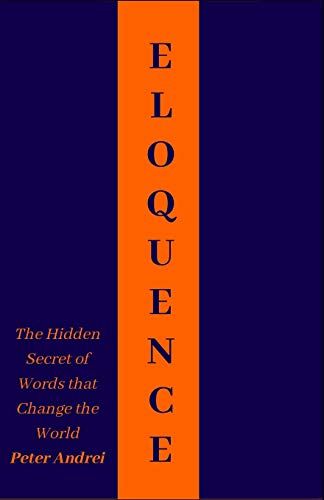Communications expert Peter Andrei breaks down the inaugural speeches of former US presidents Ronald Reagan and Bill Clinton – two outstanding orators – to illustrate his lessons in powerful, moving oratory.

How to Talk Good
Communications expert Peter Andrei delves into the techniques of powerful speakers to uncover the source of their timelessness. He studies former US presidents Bill Clinton and Ronald Reagan – two celebrated orators. Highlighting passages from their first inaugural addresses, Andrei breaks down sentences, phrases and words to offer the “eloquence algorithm” – a formula that turns ordinary language into speeches with perpetual significance.
Alas, Andrei’s approach is limited. His eloquence algorithm is both formulaic and reliant on devices. Andrei’s analysis of these speeches is aimed at junior high students rather than a more mature audience. And any astute junior high English teacher would warn students away from excessive reliance on verbal devices.
Eloquence Algorithm
Compelling speeches motivate and captivate people. Specific rhetorical techniques leave lasting impressions. Consider, for example, Benjamin Franklin’s memorable adage, “Early to bed and early to rise makes one healthy, wealthy and wise.”
All eloquent language can be broken down into a simple set of algorithms; a prescription of steps that allow anybody to speak or write with the exact same surpassing eloquence, and to do so effortlessly, as easily as following a cooking recipe.Peter Andrei
The cadence that “wise” generates, combined with the appeal of the tricolon – three words listed together – creates a phrase that Americans have recalled for centuries.
An Emotional Chord
The inaugural speeches of former US presidents Bill Clinton and Ronald Reagan reveals their linguistic savvy. According to Andrei, Clinton’s extensive use of the pronouns “we” and “our” attempted to involve his listeners and convey that all citizens carry the spirit and the responsibility of his message. Reagan painted pictures with language to motivate and engage. For example, Reagan’s phrase “idle industries have cast workers into unemployment, human misery and personal indignity” left listeners feeling the pain of the economic downturn and craving a solution.
An essential element of eloquence is engagement. Peter Andrei
Clinton and Reagan each presented a problem, attached emotions to it and offered solutions. Reagan identified outsized government as a problem and emotionally appealed to his audience with words such as “inevitable decline” and “small dreams.” He countered this with “creative energy” and “national renewal” to lift the spirit of the speech and inspire his listeners.
Alliteration
Andrei praises the former presidents’ use of alliterative sequences – that is words containing similar sounds. For example, in the phrase “strong state,” both words start with the same sound. Eloquent orators employ multiple forms of alliteration to create rhythms. Fragmented alliteration places intervening words among like-sounding words. Reverse alliteration, or rhyming, combines words with similar ending sounds, such as “global…mobile.” Reagan paired alliteration with assonance – the repetition of vowel sounds – in his phrase, “barriers born of bigotry.” Reagan repeated the b and the o sounds to create rhythmic flow.
Contrast and Symmetry
Andrei goes on to highlight more devices: Contrast – the pairing of opposing ideas – and symmetry – the constructing of sentences with similar structures – combine to make powerful illustrations, Andrei affirms. Clinton, for example, contrasted ideas with symmetry to produce a logical flow his listeners easily grasped. His vivid phrase, “the shadows of the Cold War…warmed by the sunshine of freedom” invited listeners to feel the contrast through similar grammatical structures.
Human understanding of meaning grows deeper yet more fluent and easy as the meaning contains more and more contrast. Peter Andrei
Symmetry in the structure and the meaning of words proves compelling. Clinton stacked three action-noun combinations to poetic effect: “eroded our resources, fractured our economy and shaken our confidence.” Combining these structures in groups of three further enhances rhythmic flow and, thus, eloquence.
Strong Verbs and Modifiers
Verbs denote action, and action carries the speaker’s message. Adding modifiers – adverbs – further advances the narrative and creates mental images for the audience.
Which is more compelling? Interests? Or vital interests? Diplomacy? Or peaceful diplomacy? Americans? Or brave Americans?Peter Andrei
For example, Reagan’s description of a man’s job in a “small-town barbershop” versus simply a “barbershop” implied someone from humble origins, and Clinton’s practice of adding two adjectives – “America’s long heroic journey” versus “America’s long journey” – added dramatic flair.
Parallelism and Repetition
Strict parallelism – identical grammatical patterns of speech – and loose parallelism – linguistic constructions that display similar, though not identical structures – create an irresistible cadence.
Repetition is inherently eloquent, electrifying the audience.Peter Andrei
Reagan used parallelism effectively when he championed the men and women who “raise our food, patrol our streets, man our mines and factories, teach our children, keep our homes, and heal us when we’re sick.”
Cadence
Proficient speakers establish a tempo, then break the pattern. Reagan exemplified this while citing global battlefields on which the American military fought. He presented lists of four, creating a pattern: “Their lives ending in places called [four locations] and halfway around the world on [four locations]…” But he finished with a single word: Vietnam. This pattern break evoked strong emotions.
Humans are pattern-recognizing creatures. We recognize a new stimulus, we observe it until we perceive its predominating patterns, we observe these patterns, and then we let them fade into the background as they grow predictable.Peter Andrei
When citing three or more examples, grammar dictates the writer must insert a conjunction. Omitting that conjunction provides a jolt. Clinton describes Americans as a “restless, questing, hopeful people,” omitting the “and.”
Clinton’s phrase “our hopes, our hearts, our hands” used symmetry – each phrase has an identical structure. He inspired inclusion with the word “our” and applied assonance and consonance with repetition to create rhythmic flow. Finally, Clinton harnessed alliteration.
Basic Interpretation
Andrei loves language and has linguistic skills. His voice is conversational, almost intimate, and easy to enjoy. He deploys the rhetorical devices he cites with subtlety and to powerful effect. But his suggestions for building speeches from these devices are oddly reductive, even as his examples showcase rhetorical power. So, while his advice might be simplistic, Andrei’s enthusiasm for language renders his analysis fascinating.
Peter Andrei also wrote How Highly Effective People Speak, How to Master Public Speaking, The Confidence Code and Effective Communication.






